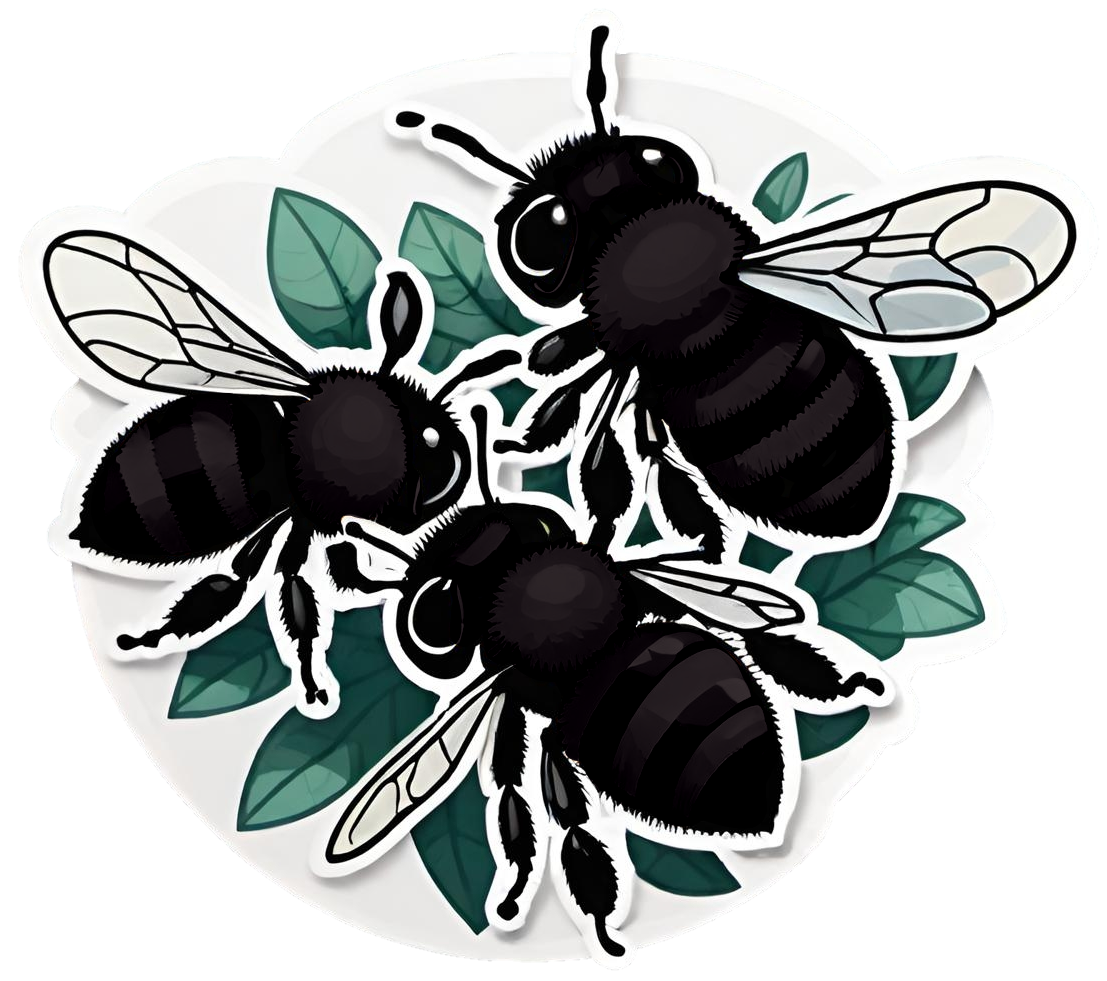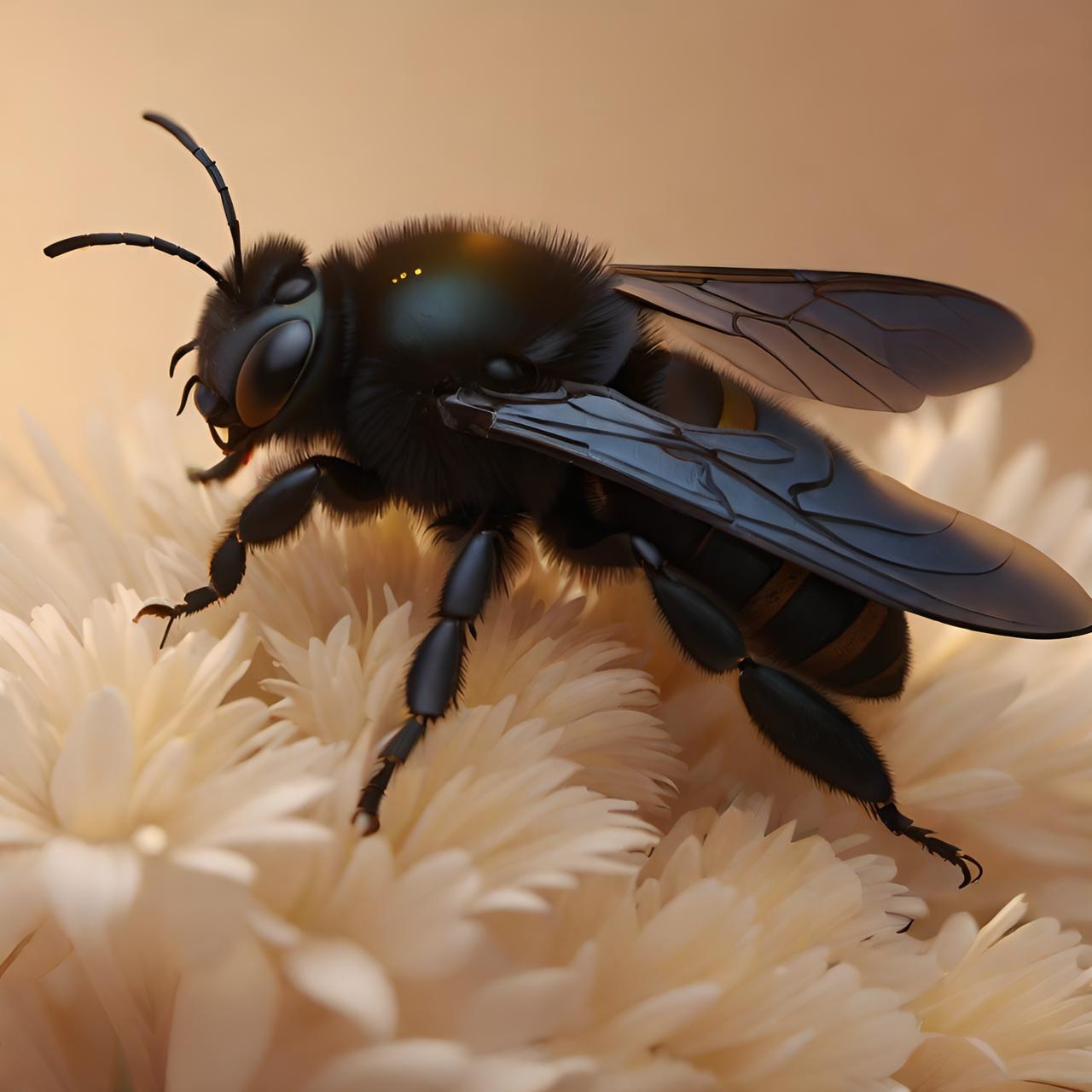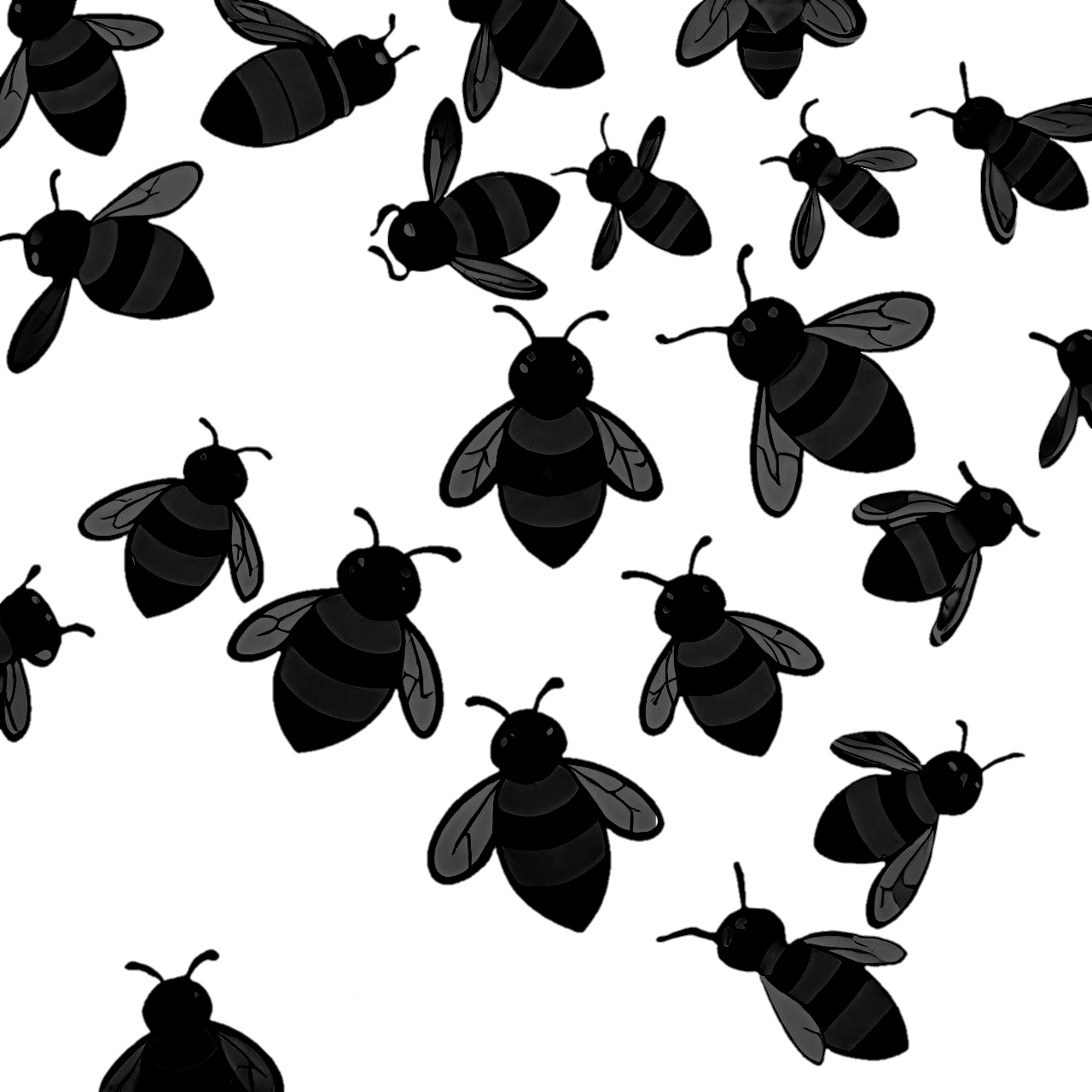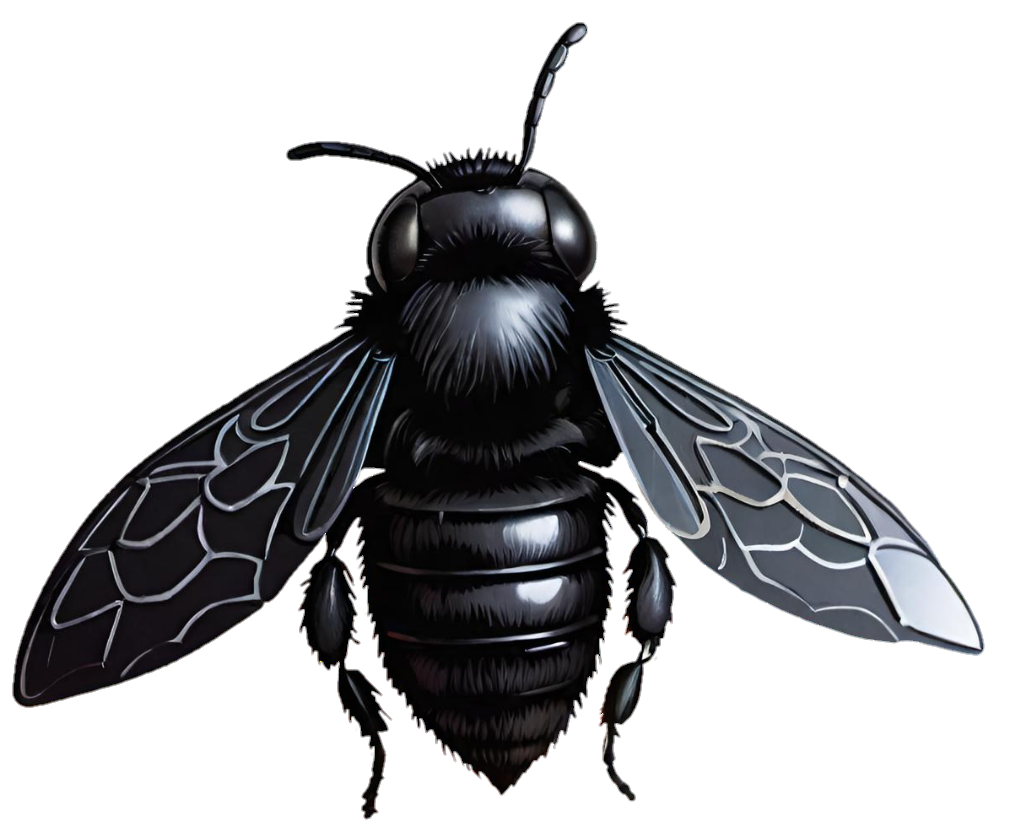Void Bees
Within the deep forests of the Tenebrous Chain are a peculiar breed of honeybee. There are many beautiful flowers which grow only in the eternal pall of the Chain's thickest forests, taking sustenance from shadow rather than light. There are also many predators within this region and so Zalikar blessed these insects with a frightful sting: Vokda's Touch. Each of these insects possess a sting which expands the space between molecules, disintegrating any material violently and leaving nothing behind. Alone, this is is an intensely painful and destructive sting but a swarm of these creatures will shred a creature apart! Despite the danger, their honey is beloved and packed with magical properties which pull from both the bees and the flowers they pollinate!
|
Vokda's Touch
Vokda's Shield
|
Anatomy |
It's size and anatomy are nearly identical to their original ancestors except that their magic form is fully pitch black. Seeing their magic form, alongside a warning dance, indicates they feel threatened and warn would be predators. Unfortunately, this can make them even more difficult to perceive in their dim natural habitat. |
Original Ancestor | Lifespan | Size |
|---|---|---|
Apis mellifera
European Honeybee |
3-5 years |
.5 inches
1.2 cm |
Coloration |
|---|
While in their normal form, these honeybees look just like any other with yellow and black stripes. But Void Bees are nearly always in their magic form, their body goes entirely black! |
Habitat |
This species is found throughout Eluziar and parts of both the Frozen Wastes and Alkelbulan. Yet they thrive best in dark habitats, especially the Tenebrous Chain where they are most prevalent. There are also hobbyists, mages and beekeepers who breed and cultivate their honey for its magical properties. They are most common within Umbral Silva and Lacuna Heath but might also be found in Terror Thicket, Melancholy Mire and even Cryptic Karst. While diurnal in the Chain, void bees become nocturnal in any other habitat! Whether this is because their camouflage is better in the dark or a natural aversion to sunlight common to many species with void magic is uncertain. Void bees nest and behave similarly to other honeybees but are far more reclusive, one might hardly notice as they frequent gardens, meadows and woodlands! Yet unlike other honeybees, they are known to nest within or at least visit the caves of the Kryptic Karst as one of its few pollinators. They are also far more tolerant of colder temperatures, if not preferring them, thanks to Vokda's Shield. |
Diet |
Void bees feed only on flowering plants, consuming nectar, pollen and sap before changing it into precious honey! This honey is ominous and ink black, cold to the touch. Worker bees gather these materials from flowers, leaves and stems, delivering them to the hive. Nectar provides carbohydrates while pollen contains proteins, fats and other nutrients. Protein is provided by a material called bee bread, constructed from fermented pollen and fed to their developping larvae. Worker bees also gather water for dilluting honey and to cool the hive and resin might be collected from tree buds to repair the hive. Occasionally, workers might even gatther a substance called honeydew, excreted from plant-sucking insects and stored away like honey. The individual diet of a void bee depends on their role in the hive as their diet determines what larvae will grow into, fed either royal or worker jelly!
These bees pollinate the unique flowers which grow only within the darkest depths of the Tenebrous Chain, able to tolerate and process even the most radical plants within this biome. Their biggest threats tend to come in the form of migratory thieves: Solar Moth.There is one particular moth nicknamed the Bee Robber for its tendency to invade their hives and steal their honey. There is little they can do beyond stay out of this moth's way, its solar magic powerful enough to destroy their entire colony if they anger it! These thieves only pester their hives for a short period before dying off, short lived and delicate. |
Life Cycle |
These insects follow a strict caste system involving workers, queens and drones which are produced both sexually and asexually. All activity within the hive centers around their queen as she is the only one capable of reproduction. They prioritize her survival over all others! She lays eggs continuously, only pausing in summer in warmer climates. She can lay around 1,000 eggs a day or 200,000 eggs over the course of her life, changing the amount of male or female workers if she is hurt or if there is a threat to the colony. There is only ever one mature queen in a hive at a time, new queens only produced when the hive is doing well. A virgin queen exits the hive in fall or winter a mere week after maturing into an adult. But an established queen may choose to leave the hive instead, taking half of the hive with her! These events are called swarming as male bees are attracted to the pheromones she releases. And if there are multiple new queens, they depart in waves called afterswarms one after another. This is because queens are ruthlessly competitive, any queens which remain fighting to the death until only one remains! No new eggs will be lain until only one queen is left. Workers are unable to lay eggs thanks to pheromones released by their queen but in cases where there is no living queen, workers are capable of laying unfertilized male eggs!
Mating only occurs when a queen departs her hive and instigates a swarm. Male drones gather just outside, attracted to her pheromones, chasing after her as she flies in predetermined directions. Male drones compete desperately with each other to mate with her despite the fact that those who are successful will die within a matter of hours. Queens mate with up to 10 males in a single flight, most from her own hive though she may occasionally attract males from other hives. She may repeat the process up to four times over the course of a few days and will never mate again in her lifetime, storing their genetic material in her body. Finally, the new queen departs with a number of workers and drones, seeking out a new site for her hive. They gather in a tree while workers seek out a new site, immediately getting to work and creating a new hive by excreting wax from their bodies and shaping it into honeycomb. She lays her eggs in these wax cells, choosing to fertilize some eggs while others remain unfertilized. Fertilized eggs hatch into female worker bees while unfertilized eggs become drones or males. Some sterile females stay within the hive to care for their young. How fast eggs develop depends on the ambient temperature but unlike their ancestors, void bees gestate best at colder temperatures rather than warm ones! Their young also need to be kept out of the sun, extremely sensitive to light to the point of burning or withering up in direct sunlight! After 28-144 hours, eggs hatch into larva. Like many other insects, eggs metamorphize into larva and then into pupa before finally transitioning into adults. Larva are small white grubs--standing out from their pitch black hive. They remain in their wax cell as they grow, fed and cared for by sterile females. These workers carefully maintain thick wax walls to protect these larva, even keeping empty cells between occupied cells and outer walls as insulation. A female larva will receive either worker or royal jelly which determines whether they become a worker or a queen. At an ideal temperature, larva mature after 4-7 days at which point they are sealed inside of their cell where they will molt, create a cocoon and pupate. They will undergo one more metamorphosis after 7-15 days, depending on their intended role, before chewing their way out as a fully developped adult! They don't continue to grow or molt after emerging, workers living for 2-4 weeks or up to a year if they survive through summer. Males only live for 4-8 weeks as they do not endure through summer while a queen can live up to 5 years! |
Domestication |
Like their ancestors, void bees craft honey. Due to the magical properties of the flowers they pollinate and the bees themselves, their honey has a variety of properties depending on the flowers they feed on. This honey is not only incredibly useful for material magic, enchantments, alchemy and the like but it is also a unique delicacy. It is in fact a favorite treat of Zalikar himself and his aspects, especially Azowyr and Vokda. Some of these umbral honeys, as some call them, even have hallucinogenic properties. It is highly sought after! |














Comments